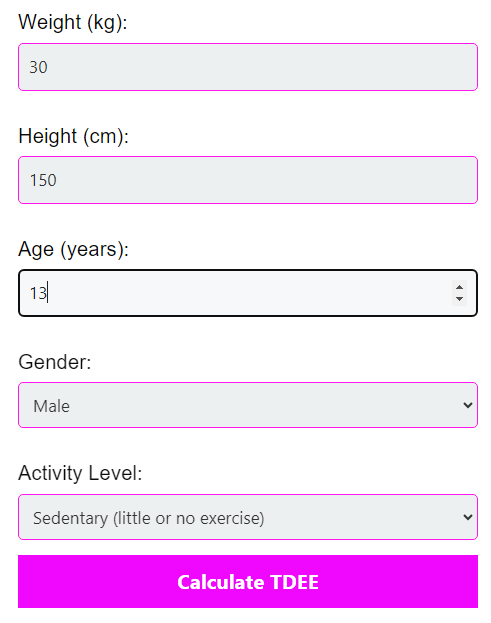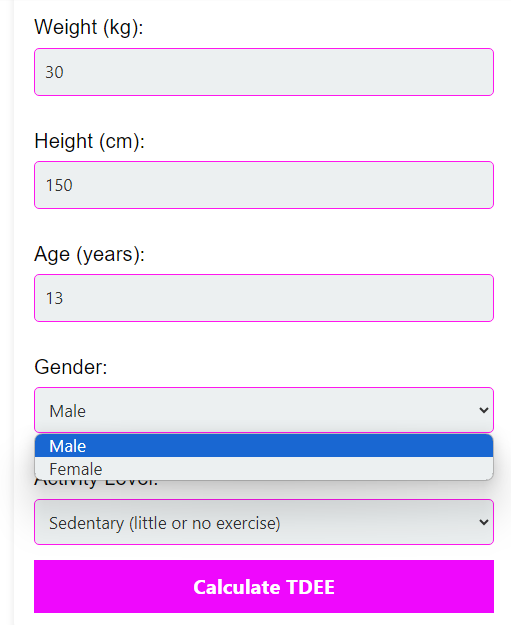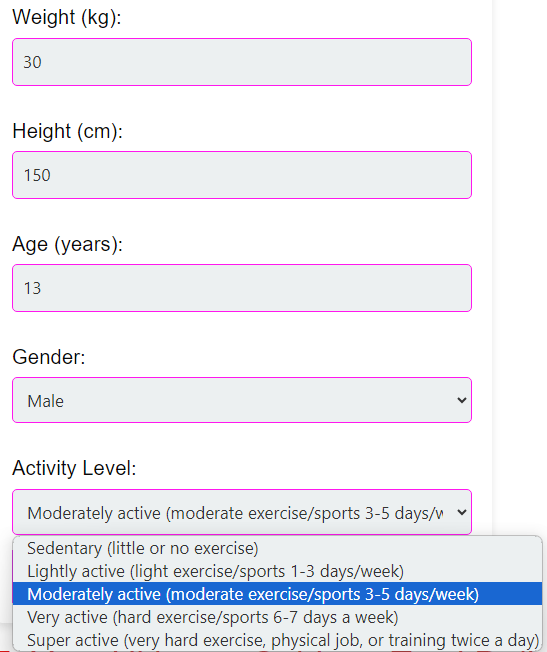Your TDEE is: calories/day
| TDEE Range (calories/day) | Feedback |
|---|---|
| Below 1500 | Your TDEE is on the lower side, indicating a need to assess your diet and activity level. |
| 1500 – 2500 | Your TDEE is within a healthy range. Keep up the balanced diet and regular activity. |
| Above 2500 | Your TDEE is high. Ensure you’re maintaining a balanced diet and engaging in sufficient activity. |
Understanding TDEE: Your Ultimate Guide to Total Daily Energy Expenditure
Guys, we are here to present your every daily needed calculator . When it comes to managing your weight, one of the most important concepts to understand is your Total Daily Energy Expenditure (TDEE). Whether you're trying to lose weight, gain muscle, or simply maintain your current weight, knowing your TDEE is key to achieving your goals. In this blog post, we'll explore what TDEE is, how it's calculated, and how you can use a TDEE calculator to take control of your health.

TDEE stands for Total Daily Energy Expenditure, which is the total number of calories your body burns in a day. It includes all the energy you expend through basic bodily functions (like breathing and digestion), as well as the energy you burn through physical activities and exercise. Essentially, your TDEE represents the number of calories you need to maintain your current weight.
Understanding your TDEE is crucial because it helps you determine how many calories you should consume daily. If you eat more than your TDEE, you’ll likely gain weight, and if you eat less, you’ll likely lose weight.
How to use our TDEE calculator:
Here's a step-by-step description of how to use a TDEE calculator, including inputs like Weight, Height, Age, Gender, and Activity Level:
Step 1: Enter Your Weight (kg)
- Input your current body weight in kilograms. This is crucial for calculating your Basal Metabolic Rate (BMR), which is a key component of your TDEE.

Step 2: Enter Your Height (cm)
- Provide your height in centimeters. Your height, along with your weight, helps determine how many calories your body burns at rest.

Step 3: Enter Your Age (years)
- Input your age in years. As you age, your metabolism generally slows down, which impacts your BMR and TDEE.

Step 4: Select Your Gender
- Choose your gender (male or female). Gender affects your BMR calculation, as men and women have different metabolic rates due to differences in body composition.

Step 5: Choose Your Activity Level
- Select the activity level that best describes your daily routine:
- Sedentary: Little to no exercise (e.g., desk job).
- Lightly Active: Light exercise or sports 1-3 days a week.
- Moderately Active: Moderate exercise or sports 3-5 days a week.
- Very Active: Hard exercise or sports 6-7 days a week.
- Super Active: Very hard exercise and a physically demanding job.

Step 6: Calculate Your TDEE
- Once you've entered all the necessary information, click the "Calculate" button. The calculator will process your inputs and provide you with your TDEE, which is the estimated number of calories you burn in a day.

This process makes it easy to understand how many calories you should be consuming based on your individual characteristics and lifestyle.
Components of TDEE
TDEE is made up of several components:
Non-Exercise Activity Thermogenesis (NEAT): This is the energy expended for everything we do that is not sleeping, eating, or sports-like exercise. It includes things like typing, cooking, and even small gestures. NEAT can vary significantly from person to person.
Basal Metabolic Rate (BMR): This is the number of calories your body needs to perform basic functions like breathing, circulating blood, and maintaining body temperature. BMR accounts for about 60-70% of your TDEE.
Thermic Effect of Food (TEF): This is the energy your body uses to digest, absorb, and metabolize food. TEF accounts for about 10% of your TDEE.
Physical Activity: This includes all the calories you burn through movement, including exercise and daily activities like walking, cleaning, or even fidgeting. Physical activity can account for anywhere from 15-30% of your TDEE, depending on your level of activity.
How to Calculate Your TDEE
Calculating your TDEE can seem complex, but it’s easier than you might think. The first step is to determine your Basal Metabolic Rate (BMR). There are several formulas to calculate BMR, but one of the most popular and widely used is the Mifflin-St Jeor Equation:
- For men:
BMR = 10 × weight (kg) + 6.25 × height (cm) - 5 × age (years) + 5 - For women:
BMR = 10 × weight (kg) + 6.25 × height (cm) - 5 × age (years) - 161
Once you have your BMR, you can calculate your TDEE by multiplying your BMR by an activity factor that reflects your lifestyle:
Super active (very hard exercise & a physical job): BMR × 1.9
Sedentary (little or no exercise): BMR × 1.2
Lightly active (light exercise/sports 1-3 days/week): BMR × 1.375
Moderately active (moderate exercise/sports 3-5 days/week): BMR × 1.55
Very active (hard exercise/sports 6-7 days a week): BMR × 1.725
Using a TDEE Calculator
While calculating your TDEE manually can be informative, using an online TDEE calculator is a quicker and easier option. A TDEE calculator will ask for your age, gender, weight, height, and activity level, and will automatically calculate your BMR and TDEE for you. Guys, if you are not sure about our tool or have any doubts then read the question with an answer briefly.
Why Use a TDEE Calculator?
Goal Setting: Whether you’re looking to lose weight, build muscle, or maintain your current physique, a TDEE calculator can help you set realistic calorie goals to achieve your objectives.
Accuracy: A TDEE calculator provides a more accurate estimate of your daily caloric needs by considering various factors like your age, height, weight, and activity level.
Time-Saving: Calculating TDEE manually can be time-consuming and prone to errors. A calculator does the job in seconds.
How to Use Your TDEE to Reach Your Fitness Goals
Guys, Now that you know your TDEE, you can use it to help achieve your fitness goals and maintain your fitness:
To maintain weight: Simply eat your TDEE. This means consuming the same number of calories that your body burns in a day.
To lose weight: Create a calorie deficit by eating fewer calories than your TDEE. A common approach is to reduce your intake by 500 calories per day, which should result in about 0.5 kg (1 lb) of weight loss per week.
To gain weight/muscle: Create a calorie surplus by eating more calories than your TDEE. Aim to increase your intake by 250-500 calories per day, depending on your goals.
Our Final Thoughts
Understanding your TDEE is a fundamental aspect of managing your weight and overall health. Whether you choose to calculate it manually or use a TDEE calculator, knowing this number can empower you to make informed decisions about your diet and exercise routine.
Remember, while TDEE gives you a good estimate of your daily caloric needs, individual factors like metabolism, muscle mass, and genetics can also influence your actual energy expenditure. Always listen to your body and adjust your caloric intake as needed to meet your goals.
Disclaimer
The information provided in this blog post is for educational and informational purposes only. While we strive to provide accurate and up-to-date content, the TDEE calculations and recommendations are based on general formulas and may not reflect individual variations such as metabolism, medical conditions, or specific dietary needs.
Before making any significant changes to your diet, exercise routine, or lifestyle, we strongly recommend consulting with a healthcare provider, registered dietitian, or qualified fitness professional. This blog post should not be used as a substitute for professional advice or guidance.
Your use of any information or calculators provided on this site is at your own risk. We are not responsible for any consequences that may arise from following the advice or using the calculators provided.
